yeovil at war
air raids
The ten air raids on Yeovil
With Westlands factory and airfield a prime target for German Luftwaffe bombing raids, Yeovil prepared for war. While the town became festooned with barrage balloons, searchlight detachments and anti-aircraft gun batteries, air raid sirens were mounted at three sites around Yeovil in order to give the greatest coverage of the warning of an imminent attack. One was mounted on the roof of the police station / court building in Petters Way, a second was on Yeovil School in Mudford Road and a third was on 166 Hendford Hill, close to the Quicksilver Mail. The first alarm was raised on 5 July 1940 and between then and the final alarm of 16 June 1944 there were a total of 365 air raid warnings.
For details of all civilians killed in the air raids on Yeovil - click here
|
Yeovilians
remember... However, as we were under the path of the bombers coming from the west of France, proceeding north to Bristol, Liverpool, Manchester etc. we were under constant nightly air raid alerts. Coupled with the proximity of the Houndstone Camp guns, we also had to endure a number of heavy Naval guns located on the other side of Summerhouse Hill. For hours the windows and house shook and rattled. It would die down and then start again as the bomber aircraft returned. With disturbed sleep and early morning work requirements, it was tough. After a while we got used to it, and by staying in bed, it was possible to sleep through most of it. I had a personal experience of close up bombing - one summer evening I was over at the Westland Sports Club. It was quiet with hardly anyone there, probably as we had had an air raid in the town that day. Some bombs had been dropped on Station Road, and in the middle of the Town where the old Town Hall used to be in High Street. I was outside the clubhouse when I glanced up and saw three aircraft approaching. I recognised them as not being ours so I ran into the clubhouse and dived under the big billiard table. The planes shed their load of bombs and the building shook so much that the table lifted several inches off the floor. I raced outside and the eerie quiet was being broken by a dog barking and the distant clanging of fire engine bells and sirens. It was now dark, gas mains were flaring and a crater which extended from one house to the other side of the road was blocking the rescue squads. On the path outside were the remains of an Anderson air raid shelter. A whole family had been wiped out with a direct hit. I decided to get away from there in case of a follow up aircraft group should appear. Finding a muddy path around the edge of the airfield, I got home as fast as I could through the town. Atrocity? No. The Westland factory was camouflaged to blend in with all the houses both sides of the airfield. Unfortunately the enemy planes approached from the east instead of the west, hence the mistake."
Memories
of the
late
Walter
McGowan
.... and many thanks to the late Tony Robins for the following - "We had our windows blown out several times, the blackout curtains thrown across the room and the ceilings brought down; these were repaired with Essex Boarding, sheets of fibreboard Dad bought from Bradford’s building merchants. When the air-raid siren sounded, mum, dad and myself sheltered under the stairs as it was thought the safest place. My brother wouldn’t get out of bed, he said "I’d sooner go down with the rubble than be buried under it."
.... many thanks also to Richard Venus, evacuated to Yeovil from London between 1939 and 1942, who recalls this experience - "One vivid memory is of a wartime experience. I was going to school which entailed walking up this long inclined road (Orchard Street) near to an army depot. It must have been cold as I was wearing a long overcoat with cap and gas mask box. There was low cloud and I could hear this aeroplane above me which was obviously flying very low. As I was looking up this plane came out of the clouds right overhead. It was a German bomber. It had two engines and was painted black with a white German cross on it. It was low enough to see the airmen in it. Then it started firing its machine guns at me. Well I thought it was firing at me but it was probably just firing at the army vehicles next to me. A passing man threw me down on the ground and laid on top of me. It was all over in seconds. The man picked me up and told me to get off to school straight away. You can imagine the story I told at school. It no doubt got embellished in the telling."
.... and almost certainly the same raid, this story is courtesy of Anthony Davies. "My mother use to tell a story about being housed for a short time near the end of the airfield at Yeovil and while putting out the washing one day, a German plane flew very low, so low, that Mum said she could see their faces. The plane was machine gunning, mum run back into the house and hid under the stairs being so frightened, I guess this being the best dedicated safe place in case of an air raid. Unfortunately the latch dropped on the door which left mum locked in for many hours until a friendly air raid warden hearing her shouts came to her rescue and let her out."
|
Fortunately there were only ten actual raids on Yeovil itself (plus a few minor incidents), although 49 people were killed and 122 injured. Much damage was done with 68 properties completely destroyed and 2,754 damaged. Although Westlands was the prime target, only two bombs ever hit the factory and production was hardly affected by the bombing raids.
All known raids on the town are listed below, with the ten major raids highlighted and numbered.
Friday 9
August 1940
A small air raid
occurred in the
early hours by a
lone Junkers
Ju88 dropping
four HE bombs at
Chilthorne
Domer. Its
likely target
was Yeovilton
but it was
intercepted by
Hurricanes of
'Blue Section',
213 Squadron out
of Exeter and
had to dump its
bombs in a
hurry. The Ju88
sustained damage
but managed to
return to its
base although
the gunner was
killed. It was
probably the
same gunner who
had shot down
and destroyed a
barrage balloon
at Yeovil. Other
than the German
gunner, there
were no
casualties.
Wednesday 18
September 1940
An own-goal was
scored when a
Wellington
bomber hit a
Yeovil barrage
balloon during
the night. Three
of the crew
baled out, with
one being
seriously
injured. The
remaining three
crew members
stayed on board
and the
Wellington
returned safely
to base.
Wednesday 25
September 1940
Some seventy
enemy bombers
with escorting
fighters
approached
Yeovil during
mid-morning.
Thinking that
the Westland
aircraft works
may be their
target,
controllers
scrambled No 238
Squadron from
Middle Wallop
with orders to
head for a
location ten
miles south of
Yeovil and all
other fighters
in 10 Group were
ordered to
Yeovil. Further
squadrons were
brought to
readiness but
the enemy
formation of
bombers passed
over Yeovil and
continued on
towards
Weston-super-Mare.
Monday 30
September 1940
During the late
afternoon a
force of forty
Heinkels,
escorted by
Messerschmitt Bf
110s, crossed
the coast near
Weymouth heading
for the Westland
aircraft works.
Because of heavy
cloud obscuring
the ground, the
enemy had to
bomb blind.
Sadly, Sherborne
took the full
force of the
bombing raid. In
all Sherborne
lost ten killed
and some fifty
injured, twenty
houses were
destroyed and
some 300 more
were damaged.
Air
Raid No 1:
Monday 7 October
1940
The first major
Luftwaffe raid
on Yeovil occurred in the
afternoon when a
flight of twenty-five
Junkers Ju88
twin-engine
medium bombers,
escorted by some
fifty
Messerschmitt Bf
110s,
dropped over
thirty high
explosive bombs
and eighteen oil
bombs on Yeovil.
The German force
was attacked by
five squadrons
of fighters from
No 10 Group, who
shot down seven
Bf 110s and a
Ju88.
Burton's outfitters shop next to Woolworth's in Middle Street was destroyed killing eight and a direct hit on the Methodist church public shelter in Vicarage Street killed four people. A stick of bombs falling across Grove Avenue, Summerleaze Park (now Parcroft) School, Summerleaze Park and St Andrew's Road killed a further four people. Other bombs fell in the Roping Road area and Addlewell Lane. In all 16 people were killed and 29 injured as a result of this raid.
This was reported in the press to be the first concentrated attack on a Somerset town.

Courtesy of
Richard Gibbs.
This
colourised photograph
features in
my 2024 book "Yeovil,
the Home
Front,
1939-1945"
No 12 Grove Avenue, partially destroyed by a German bomb but later repaired.

This
colourised
photograph
features in
my 2024 book "Yeovil,
the Home
Front,
1939-1945"
This photograph dates to the late 1940s or early 1950s - at centre is seen the bomb damaged Burton's tailors shop and the damaged Woolworth's building next door.
Air
Raid No 2:
Tuesday 8
October 1940
The following
day, around
breakfast time,
German bombers
dropped forty-four high
explosive bombs
across western
Yeovil centred
around
Westbourne Grove
and Preston
Grove. A direct
hit on an air
raid shelter in
a garden of
Preston Grove
killed eleven
people and three
others were
injured. Five
houses were
completely
destroyed and
over fifty
suffered damage.
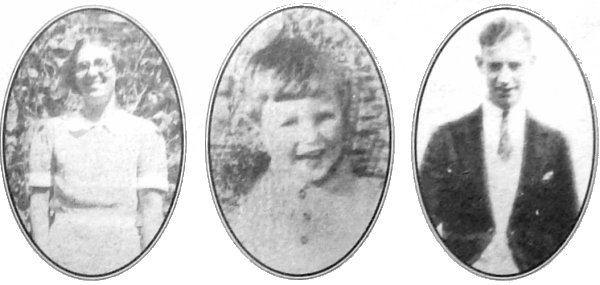
Courtesy of Rob
Baker
Joyce, three-year old Maxwell and Jimmy Fitkin, who were all killed when a German bomb landed on their air raid shelter in Preston Grove.
In all 11 people were killed and 3 injured as a result of this raid.
Air
Raid No 3:
Saturday 12
October 1940
In the early
evening a single
Luftwaffe bomber
dropped five
bombs across the
town centre,
Park Street and
Penn Hill,
injuring five
people. A wing
of
Church House
was destroyed
and much stained
glass in St
John's church
was shattered.
In the same raid
four HE bombs
were dropped on
Houndstone
Military Camp,
killing five
personnel and
injuring a
further
thirty-two.

This
colourised photograph
features in
my 2024 book "Yeovil,
the Home
Front,
1939-1945"
Church House lost a wing during a Second World War bombing raid – at 8:15pm on Saturday 12 October 1940. This photograph of the damaged house was taken in 1942.
Monday 14
October 1940
Lufton Military
Camp was
attacked by a
low-flying
single enemy
bomber. this
caused the death
of thirteen
military
personnel and
sixteen injured.
One of those
killed was the
CO of 208 AA
Regiment, Royal
Artillery,
Colonel GFR
Wingate OBE,
brother of the
famous Major
General Orde
Wingate of the
legendary 'Chindits'.
Several huts
were destroyed
by fire.
Air
Raid No 4:
Wednesday 16
October 1940
Mudford Road was
bombed in the
evening,
injuring three
people,
destroying five
houses and
damaging a
further
seventeen
properties.
Wednesday 6
November 1940
An officer and
two men of a
bomb disposal
unit were trying
to defuse a bomb
20 feet down a
shaft in Yeovil
when the bomb
exploded,
killing all
three men
instantly.
Thursday 27
February 1941
A single enemy
aircraft flew
low over Yeovil
and then
proceeded to
machine-gun
Houndstone Camp.
There were no
casualties.
Air
Raid No 5:
Wednesday 26
March 1941
Having endured
four air attacks
in little over a
week in October
1940, there was
a respite until
this attack just
before lunchtime
when a single
Luftwaffe bomber
attacked the
Westlands
factory. Four of
its HE bombs
exploded across
the Westland
estate and two
actually hit the
factory - the
only bombs to
succeed
throughout the
whole war. The
valuable work
for the war
effort in the
factory was
delayed by an
hour. Five
people were
killed in
Westland Road
and four were
killed in the
factory.
Another
thirty six
people were
injured.
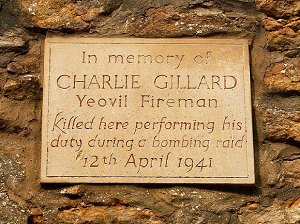 Air
Raid No 6:
Good Friday 11
April 1941
Air
Raid No 6:
Good Friday 11
April 1941
Late in the
evening several
delay-action
bombs hit the
town centre.
These were
designed to
explode some
time after
impact, with the
bomb's fuses set
to delay the
explosion for a
period lasting
anywhere from
just a few
seconds to
several weeks.
Short delays
allowed the bomb
to penetrate
before exploding
whereas longer
delays were
intended to
disrupt bomb
disposal and
other activities
as well as
spreading
terror. All the
bombs exploded
before the
'all-clear'
siren sounded
with one
demolishing the
WVS Headquarters
and another
destroying the
Medical Hall
(the upper floor
was being used
as an Evacuee
Canteen,
fortunately
closed at the
time of the
raid) and three
other shops in
the Borough and
another killing
four soldiers of
the King's Own
Scottish
Borderers
billeted in the
Corn Exchange
behind the
municipal
offices in King
George Street.
While fighting
the fire in the
Corn Exchange
Auxiliary Fire
Service Patrol
Officer
Charlie
Gillard was
killed when the
delay-action
bomb exploded in
the Corn
Exchange in the
early hours of
12 April. A
tablet
(photographed
above) on the
remains of the
Corn Exchange
was erected in
his memory. One
of the bombs
destroyed the
old
Medical Hall
in the
Borough used
by Boots the
Chemist. In all
5 people were
killed and 14
injured as a
result of this
raid.
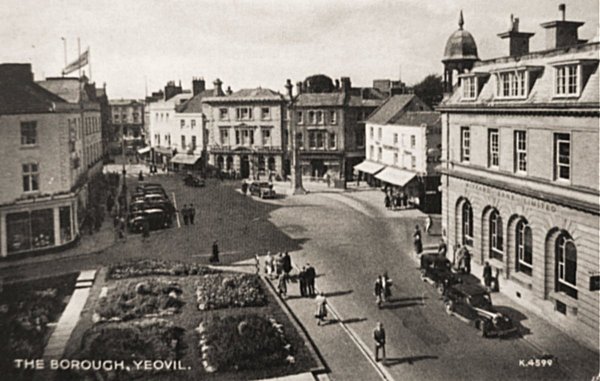
This postcard dates to 1947 and shows an unusual view of the Borough. Wine Street runs off to the left, High Street is at top left and Middle Street runs to the bottom right corner. The gardens at bottom left mark the site of the bombed Medical Hall and were planted with tulips donated by Dutch children who had been evacuated to Yeovil during the war.
Air
Raid No 7:
Thursday 8
May 1941
Around midnight
a Luftwaffe
bomber hit the
steel cable of
the barrage
balloon of
Yeovil barrage
balloon site No
5, south of
Plackett Lane,
cutting the
balloon adrift.
The bomber released its
bombs as a
precautionary
measure, but
apart from
hitting the
accommodation
hut of the
balloon crew the
bombs all landed
in fields. There
were no
casualties. Two
of the bombs
landed near the
GWR line near
Yew Tree Farm
but failed to
explode.
Air
Raid No 8:
Friday 16 May
1941
Around midnight
a single German
bomber bombed
the fields north
of Mudford Road
between St
Michael's Avenue
and Stone Lane.
There were no
casualties,
apart from a
couple of cows,
and just a few
windows were
blown in by the
blasts.
Air
Raid No 9:
Sunday 25 May 1941
Just after
midnight on
Sunday morning a
single Dornier bomber
dropped a stick
of fourteen high
explosive bombs
from a very low
level
across Mudford
Road killing
five people and
injuring a
further seven.
Eight houses
were completely
destroyed and
115 were
damaged.
Air
Raid No 10:
Wednesday 5
August 1942
After more than
a year without
air raids, this
final air raid
was carried out
by two Luftwaffe
Focke Wulf 190
fighter-bombers.
After strafing
the town with
20mm cannon fire
each dropped an
1,100lb (500kg)
bomb; one landed
in rear gardens
near the
junction of
Grass Royal and
Gordon Road
while the second
bomb hit the
ground, bounced
some 200 yards,
cleared a number
of houses and
finally
exploded in
Dampier Street.
Three people
were killed and
twenty five were
injured, of
which thirteen
were detained in
hospital. Fifteen
houses were
destroyed and a
further 972 were
damaged.
The following photographs are of the bomb damage caused by the first bomb to houses in Matthews Road and Gordon Road.

Courtesy of Rob
Baker.
This
colourised photograph
features in
my 2024 book "Yeovil,
the Home
Front,
1939-1945"
Damage to houses in Matthews Road (the rear of the block on the east side, adjoining Gordon Road).
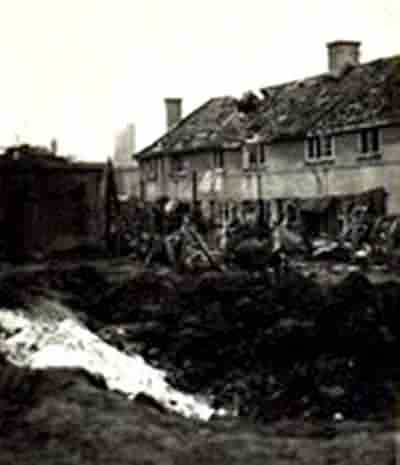
Courtesy of Rob
Baker
This photograph shows the path of the bomb as it ran down the roof slope in Matthews Road and across gardens. The crater is seen in the foreground.
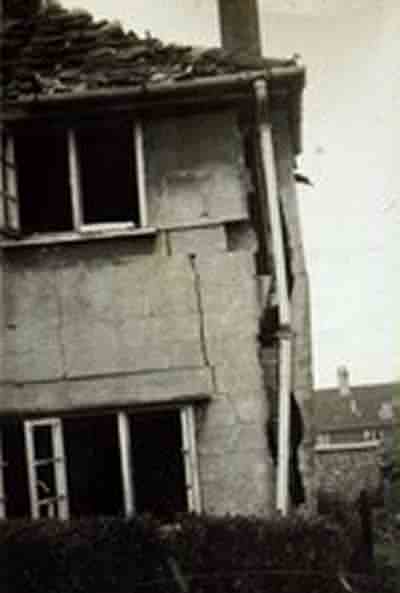
Courtesy of Rob
Baker
This photograph, of a house in Matthews Road, shows bomb damage to the breeze block and concrete slab wall that has been sucked out by blast effect.
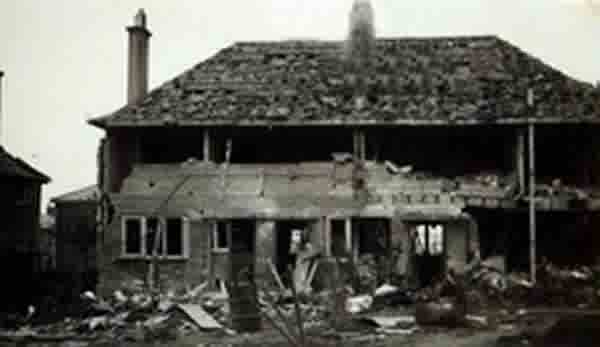
Courtesy of Rob
Baker
Bomb damage to a pair of semi-detached houses in Gordon Road approximately fifty feet from the crater.
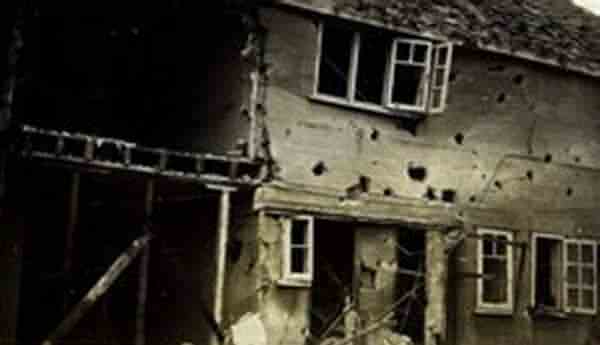
Courtesy of Rob
Baker
Fragmentation and blast damage to a semi-detached pair of houses in Gordon Road approximately sixty feet from the crater.
Friday 8
August 1942
Enemy aircraft
machine-gunned
barrage balloons
at Yeovil during
the evening of
the 8th, but no
damage was
reported.
Friday 23
October 1942
An enemy
aircraft was
reported over
Yeovil at
4:15pm, flying
southeast. It
dropped no bombs
but was engaged
by anti-aircraft
fire. The same
day Yeovil lost
two barrage
balloons; one
was grounded at
Glenthorne
Avenue while the
other was last
seen drifting
off to the east.
|
"Everyone used torches in the blackout as the only light we ever saw outside at night was moonlight, so a lot of the time everywhere was black. If we had a long way to walk at night we would shine the torch on the ground several yards in front and as we walked we would switch the torch on and off every five seconds or so, this was supposed to make the battery last longer."
Memories
of Brian
Walker |
gallery
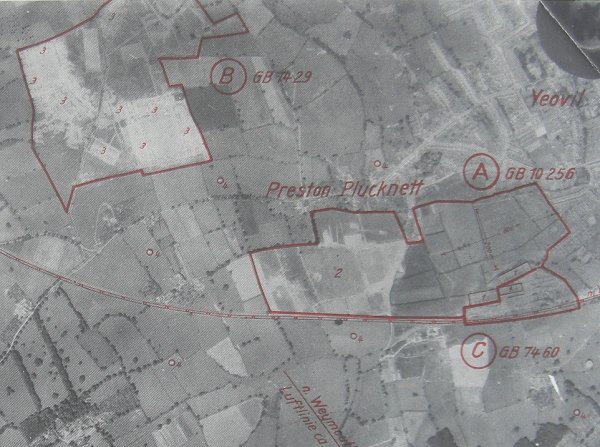
Courtesy of
Yeovil Library
This is part of a German reconnaissance photograph of the Second World War taken by a Zeppelin in 1939 and highlighting the targets of Westland's Airfield (marked 'A'), Lufton Army Camp and Houndstone Army Camp (marked 'B') and the Westland factory (marked 'C'). Within 'A' are three aircraft hangers marked '1' in the lower right corner and the airfield itself is marked '2' - note how the airfield has been camouflaged by pouring oil on the grass to create the appearance of hedges around small fields. Within 'B' are several barracks huts, each marked '3'. Dotted around the map and marked '4' are several sites of 'Fesselballons' or barrage balloon sites.